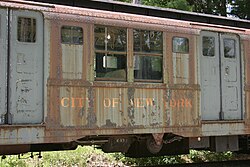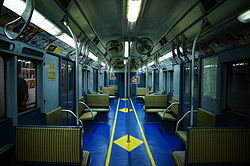R7A (New York City Subway car)
| R7/A | |
|---|---|

An R7 car at the Seashore Trolley Museum
|
|

Interior of R7A car 1575
|
|
| Manufacturer | American Car and Foundry, Pullman Standard |
| Built at | Chicago, Illinois, USA |
| Family name | Arnines |
| Constructed |
|
| Entered service | 1938-1939 |
| Scrapped | 1978-1979 |
| Number built | 250
|
| Number preserved | 2 (1 R7, 1 R7A) |
| Number scrapped | 248 (149 R7s, 99 R7As) |
| Fleet numbers |
|
| Capacity | 56 (seated) |
| Operator(s) | New York City Subway |
| Specifications | |
| Car body construction | Riveted steel |
| Car length | 60 feet 2 1⁄2 inches (18.35 m) over anticlimbers |
| Width | 10 ft (3.05 m) |
| Height | 12 feet 1 5⁄8 inches (3.70 m) |
| Platform height | 3.76 ft (1.15 m) |
| Doors | 8 |
| Maximum speed | 55 mph (89 km/h) |
| Weight | 84,556 lb (38,354 kg) (ACF), 84,750 lb (38,440 kg) (Pullman), #1575: 82,340 lb (37,350 kg) |
| Traction system | Westinghouse 570-D5 or General Electric 714-D1, 714-D2 |
| Power output | 190 hp (142 kW) |
| Electric system(s) | 600 V DC Third rail |
| Current collection method | Contact shoe |
| Braking system(s) | WABCO Schedule AMUE with UE-5 universal valve, ME-23 brake stand, and simplex clasp brake rigging. WABCO D-3-F air compressor |
| Coupling system | WABCO H2A |
| Track gauge | 4 ft 8 1⁄2 in (1,435 mm) |
The R7 was a New York City Subway car model built in 1937 for the city-operated Independent Subway System by two manufacturers under separate orders, the American Car and Foundry Company and Pullman Standard.
On March 5, 1937, the New York City Board of Transportation opened up bids for 150 cars to be built under the R7 contract–a continuation of the R6 fleet. The winning bid for $40,375 per car was jointly submitted by the American Car and Foundry Company (ACF) and Pullman Standard. The Pressed Steel Company also submitted a bid, for $40,850 per car. On July 27, 1937, it was announced that the winning bid for 100 additional cars, under contract R7A, went to ACF and Pullman for $41,951 per car. Additional bids were made by Pressed Steel ($42,200) and Bethlehem Steel ($43,100). The increased in price per car was attributed to strikes in the steel industry. Together, these two orders provided additional cars for expanded service in Queens and for the opening of the IND Crosstown Line. The R7As were built in 1938. The R7s and R7As were used for service on the IND exclusively until 1968 or 1969, when they were displaced from the IND by the new R40s and R42s and transferred to the East New York Yard.
Many R7/As were replaced by the R44s. Most other cars ran on the Eastern Division until 1977, when they were finally replaced by the R46s.
R7 car 1440 survives at the Seashore Trolley Museum in Kennebunkport, Maine. It was modified with trolley poles and is used in various tourist rides around the museum, often coupled to R4 car 800.
...
Wikipedia
